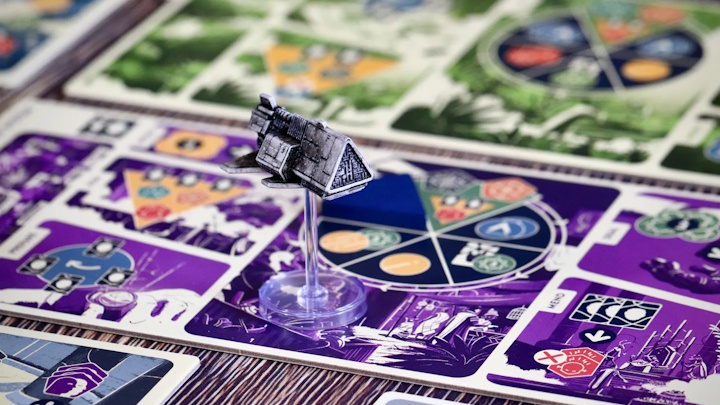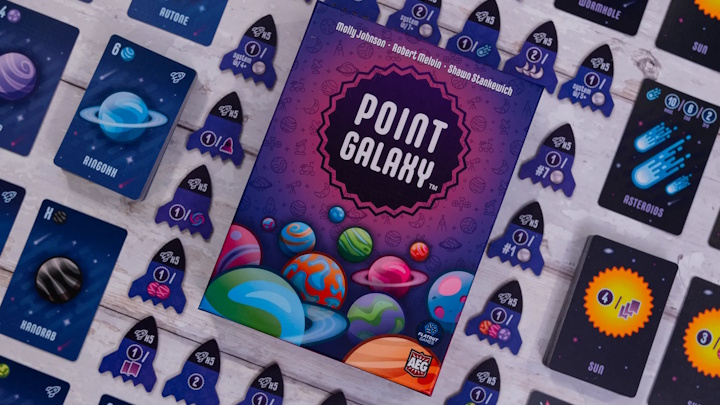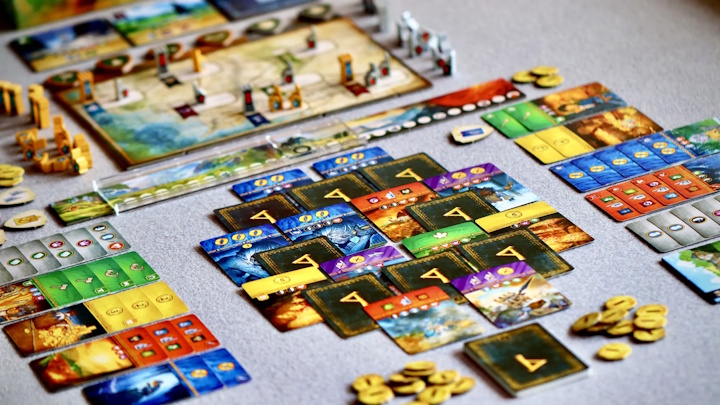Board Games in 2025
01 Jan 2026A good year for board games. Convention-wise, I made it to OrcaCon in January, PAX West in September, and PAX Unplugged in November. Those are my biggest discovery times, but there was a steady drip of playing throughout the year.
Below are the board games I played in 2025 that I have something to say about.
Sea Salt & Paper
 This tiny box delivers a lot of game. Each turn you either take a face up card from one of two piles, or draw from a deck and choose one of two cards (discarding the other to the face-up piles). Collect sets for points, or specific pairs to trigger abilities in game (like digging deeper into the discard). When you think you have the most points beyond some threshold, declare so and see how it plays out. It’s simple, fast, and has more interesting decisions than you’d think. It’s also worth noting that the origami art is really charming. But the size of the box (a standard deck of cards) is what makes this hyper portable and thus hyper relevant.
This tiny box delivers a lot of game. Each turn you either take a face up card from one of two piles, or draw from a deck and choose one of two cards (discarding the other to the face-up piles). Collect sets for points, or specific pairs to trigger abilities in game (like digging deeper into the discard). When you think you have the most points beyond some threshold, declare so and see how it plays out. It’s simple, fast, and has more interesting decisions than you’d think. It’s also worth noting that the origami art is really charming. But the size of the box (a standard deck of cards) is what makes this hyper portable and thus hyper relevant.
2-4 players, 30-45 minutes
Castle Combo
 Each turn you will draft a character into what will eventually be a 3x3 grid. These characters each have a suit and different scoring criteria that care about placement of themselves and others. Your ability to draft is limited by currencies of coins and keys, which you will have to carefully manage earing and spending through play. It’s all highly strategic, and putting together a well scoring final grid is deeply satisfying. The art is cartoony and fun and the bits like the keys are charming. A terrific small box card game.
Each turn you will draft a character into what will eventually be a 3x3 grid. These characters each have a suit and different scoring criteria that care about placement of themselves and others. Your ability to draft is limited by currencies of coins and keys, which you will have to carefully manage earing and spending through play. It’s all highly strategic, and putting together a well scoring final grid is deeply satisfying. The art is cartoony and fun and the bits like the keys are charming. A terrific small box card game.
2-5 players, 10-25 minutes
EGO
 Thematically, you’re basically Zapp Brannigan fumbling your way through a sequence of sensitive diplomatic alien negotiations. Mechanically, you’re bidding and pushing your luck, hoping to not bust and piss off too many aliens along the way. Artistically, it’s looks far more intimidating with its alien symbology than the game actually is, but also it’s quite fetching. In my plays this has been a raucous good time. It has a smart mix of streamlined simultaneously play for most of the game, with then central moments of high drama where everyone comes together to play out a competitive bid (hoping for the top reward… or just trying to avoid the bottom place punishment).
Thematically, you’re basically Zapp Brannigan fumbling your way through a sequence of sensitive diplomatic alien negotiations. Mechanically, you’re bidding and pushing your luck, hoping to not bust and piss off too many aliens along the way. Artistically, it’s looks far more intimidating with its alien symbology than the game actually is, but also it’s quite fetching. In my plays this has been a raucous good time. It has a smart mix of streamlined simultaneously play for most of the game, with then central moments of high drama where everyone comes together to play out a competitive bid (hoping for the top reward… or just trying to avoid the bottom place punishment).
2-5 players, 40-80 minutes
Moon Colony Bloodbath
 Build a thriving colony on the moon and then watch it all fall apart. The game starts as an engine building card game, but minor inconveniences start to snowball and before you know it robots have run amuck and you need to vent some colonists into the vacuum of space just to keep the rest alive. This game has a narrative arc built into the mechanics. All while zipping along with largely simultaneously play. Excellent design, competent retro theme, love it.
Build a thriving colony on the moon and then watch it all fall apart. The game starts as an engine building card game, but minor inconveniences start to snowball and before you know it robots have run amuck and you need to vent some colonists into the vacuum of space just to keep the rest alive. This game has a narrative arc built into the mechanics. All while zipping along with largely simultaneously play. Excellent design, competent retro theme, love it.
1-5 players, 45-60 minutes
Point Galaxy
 We’ve arrived at the third iteration that started with Point Salad, and this one is my favorite. In Point Galaxy you draft cards to create various solar systems. You place planets in numeric order, you can strategically match moons, each sun provides local scoring criteria, gathering rockets gets you global scoring criteria, you can compete to have the most asteroid belts… there’s plenty to do. There are many interesting decisions to make about how to build your galaxy. And the theme comes across in an streamlined charming way. I prefer this over the other Point games for its theme and the amount of strategic crunch. For a less gamery crowd I’m still going to lean on Point Salad, but for my tastes this one is in the sweet spot.
We’ve arrived at the third iteration that started with Point Salad, and this one is my favorite. In Point Galaxy you draft cards to create various solar systems. You place planets in numeric order, you can strategically match moons, each sun provides local scoring criteria, gathering rockets gets you global scoring criteria, you can compete to have the most asteroid belts… there’s plenty to do. There are many interesting decisions to make about how to build your galaxy. And the theme comes across in an streamlined charming way. I prefer this over the other Point games for its theme and the amount of strategic crunch. For a less gamery crowd I’m still going to lean on Point Salad, but for my tastes this one is in the sweet spot.
1-5 players, 15-30 minutes
The Lord of the Rings: Duel for Middle-earth
 This is essentially 7 Wonders Duel but in Lord of the Rings trappings. And as the former is an excellent two player game and the latter is a beloved theme, I’m okay with this. It’s also possible that it slightly improves the original game with minute balance tweaks, had to say. But at the end of the day the game is solid and the presentation is delightful. There are always more things that you want than you have time to collect and you have to make hard choices every single turn.
This is essentially 7 Wonders Duel but in Lord of the Rings trappings. And as the former is an excellent two player game and the latter is a beloved theme, I’m okay with this. It’s also possible that it slightly improves the original game with minute balance tweaks, had to say. But at the end of the day the game is solid and the presentation is delightful. There are always more things that you want than you have time to collect and you have to make hard choices every single turn.
2 players, 30 minutes
And the Rest
Here are some other games I checked out this year.
Two Players
- Sirens: A small box (nearly wallet sized) two player card game where you draft cards to form a sequence of sheet music. You aspire to block in matching colored sections, put sections in the correct overall sequence, match shapes, and collect hearts. As far as 18 cards wallet games go, it’s fine. Neither spectacular nor terrible. I like where the presentation was headed with this one but overall it feels like an “almost.”
- Floristry: This is an incredibly simple spatial puzzle of matching domino tiles to create like-colored clusters. The gimmick is that which tiles you get are based on a timed auction (run on someone’s phone), where overly eager bidding will burn your ability to bid as well in the future. It’s a straightforward two player game that can be played by a very broad audience. And the presentation is charming.
Cooperative
In case you didn’t know, solo games generally work just fine as multiplayer coop games…
- Hercules and the 12 Labors: In this solo game you play through Hercules mythic story in a series of dice manipulation challenges. The production is absolutely staggering, with beautiful illustrations, creative layouts, and gold leaf shine. It’s a beautiful tiny box. The challenges are tense but you are rarely at the mercy of unmitigated raw dice. It’s a reasonable little puzzle where you get to look at beauty while you solve it.
Party Vibes
- Pinched!: As a band of thieves your pulling a heist to collect matching sets of loot. One player each turn is the mastermind and chooses the heist location. Correctly guess where they’re headed and you get more loot. As the mastermind if no one guesses correctly you get a huge hoard of loot all to yourself (and probably win the game, as this is rarer than you’d think). The barrier to playing this game is extremely low. The appeal of getting into someone’s head (or second guessing them) is there. And it’s all in an attractive package. Not terribly deep, but that’s okay.
- French Toast: One player is an alien trying to get everyone else to guess a word but they can only repeat the word that has been said aloud that is closest so far. Occasionally the alien gets to drop vague clues on a spectrum from “is” to “is not,” helping unstick everyone’s mental model of where to direct their guesses. It’s a competent party word game. My only beef with it is that overall the words seem too easy to guess; unless it’s literally the first explainer round I’m always going to use the “hard mode” deck, which isn’t as large as I’d like.
- Petiquette: The goal of the game is to find a pattern. Something we as humans are very good at doing, even when none exists. The trick is that you need to find the same pattern that at least one other person sees. Which turns this into a game of explosively declaring that your friends are crazy for not sharing your madness. The presentation for the game is cute, with dapper animals in hats.
- High Society: This is one of the highest regarded auction games out there. You have a finite set of checks to bid on various extravagances, with the goal of having the highest value assets at the end of the game but also not having the least money left over. There are also scandals to bid away, mixing up the auction mechanisms. Overall it’s a simple, focused, and solid experience. Although I will say we played it back to back with For Sale, and unanimously For Sale was considered the slightly better auction game for having fewer bad beats and overall running just a bit smoother. There’s room in the world for both.
Bigger Boxes
- Rebirth: Draw a tile, place a tile; you just need to make that one decision each turn. But you’re competing on a broad map to control territory and score secret location/majority objectives. The presentation does a lot of work here, with attractive colors, a big map, and three dimensional buildings to place on it. It’s also not hard to learn to play, and seems to have some meat to it. I’d be interested to play more.
- Deep Regrets: It’s impossible to evaluate this game independent of its presentation, because the graphic design and art and components (cute buoy dice!) are so strong. Honestly, that is the top draw. It’s creepy cute weird and it works. The game? You balance going fishing with selling what you’ve fished in order to buy better gear. The buying gear part is a bit underwhelming as you only need one rod and reel but there’s randomized selection also some are just strictly better than others. The fishing part is a bit of “draw cool art, stuff happens.” I’m not certain there are many interesting choices in this game, but it certainly looks and feels pleasing as you carry on.
Trick Taking
I don’t tend to like trick taking games. I don’t understand why they are everywhere. But this year I explored a few that break the mold enough to be interesting.
- The Lord of the Rings: The Fellowship of the Ring – Trick-Taking Game: In the path to make trick taking games interesting, a huge breakthrough was made with The Crew, particularly by making it a cooperative game and having a campaign of progressing challenges. The Lord of the Rings trick taking games match that idea with a beloved story and theme. This gives each challenge so much more life, makes this a very enjoyable cooperative card game. It does play two players, although in my experience the challenge is a bit easier as it increases the amount of public information. See also The Lord of the Rings: The Two Towers – Trick-Taking Game.
- Fishing: I don’t find trick taking games compelling on their own; they need significant additional spice to achieve any flavor. Fishing accomplishes that by also being a deck builder with strong catch up mechanics. In this game you’re either scoring or pulling cards from the ocean deck that eclipse the quality of cards that everyone started with. The magic is that the cards you win against go into your deck, so losing a hand with weak cards means the winner will be playing with them in the future. It’s dynamic, swingy, and strategic.
- Dracula vs Van Helsing: In some ways this resembles a trick taking game, with ranked suits and numbered cards. But instead of playing a depleting hand of cards you’re grooming your perfect hand in secret. Each cards then go head to head in sequence in an asymmetric two player game of area control. Along the way, each card discarded has an ability to manipulate the hands and which information is public vs. secret. The thematic package around this is abstract but well presented. A solid two player game.
- My Favourite Things: Play a trick taking game, but instead of numbers you play with a set of dry-erase cards that have been adorned with each individual’s ranked tastes in some category. Which is a stronger card, “Gandalf” (category: favorite fictional characters), or “Paris” (category: favorite travel destinations)? It’s a fun gimmick, and a way to faciltate conversations about people’s preferences. Mechanically, this in no way pushes beyond the bounds of being a bland trick taking game (without suits). The instructions have you pick one item that is not your favorite, which will only beat the highest card, but I find in play it’s a bit too obvious. I like the conversation around this game more than the actual play of it.
Don’t
- Cereal Killer: This game is a delightful small package with a cute theme and faux fruit loops to seal the deal… what could go wrong? It’s a hidden movement game where one player goes house to house committing cereal crimes, and the other player is a detective trying to catch them. And… it doesn’t work. The detective has far too few clues and tools to trap the killer, who in contrast has a ton of flexibility in their movement. Far too many turns evoke “I have nothing to do” or “What’s the point?” We played this again just to make sure we weren’t missing anything, but in my evaluation this shouldn’t have made it out of the playtesting phase as is.
- The Tea Dragon Society Card Game: This game played so poorly that afterwards I went to the internet to either find out what I played wrong or to find a host of people complaining about it. I surprisingly found neither. I mean, I get it; this is more cute theme than game, and also it’s aimed for a younger player with elevated randomness. But this is a game with shockingly little agency, a ton of randomized feel bad moments, terribly balanced cards, and not a lot of upside. No thanks.